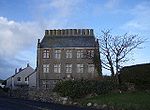Roa Island
Districts of Barrow-in-FurnessIslands of FurnessMorecambe Bay
Roa Island lies just over half a mile (1 km) south of the village of Rampside at the southernmost point of the Furness Peninsula in Cumbria, though formerly in the county of Lancashire north of the sands. It is located at 54°5′N 3°10′W (OS grid ref. SD 233650). It is one of the Islands of Furness in northern England. It has an area of about three hectares. For local government purposes Roa Island is within the Borough of Barrow-in-Furness. The island's population stands at around 100, making it the 15th most populated island in England.
Excerpt from the Wikipedia article Roa Island (License: CC BY-SA 3.0, Authors).Roa Island
Piel Street,
Geographical coordinates (GPS) Address Nearby Places Show on map
Geographical coordinates (GPS)
| Latitude | Longitude |
|---|---|
| N 54.074484 ° | E -3.174603 ° |
Address
Piel Street
Piel Street
LA13 0QJ
England, United Kingdom
Open on Google Maps








